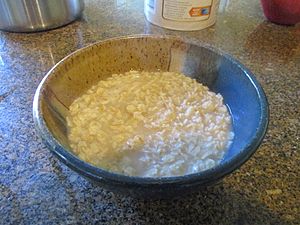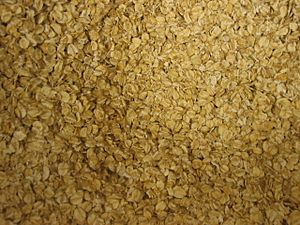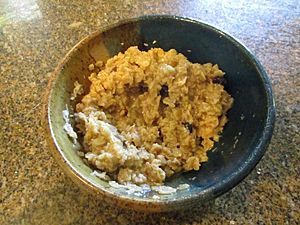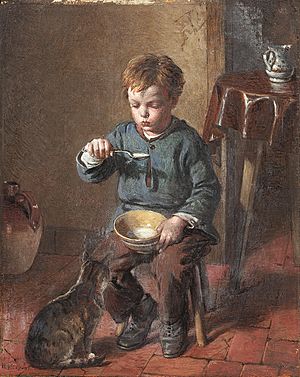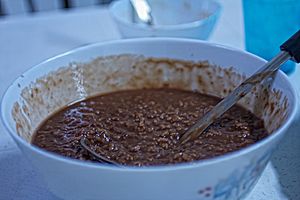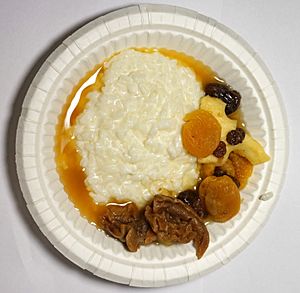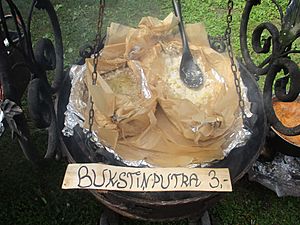Porridge facts for kids
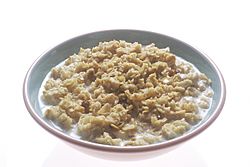
A bowl of oatmeal porridge
|
|
| Course | Breakfast |
|---|---|
| Serving temperature | Hot |
| Main ingredients | Starchy plants (e.g. grain), water or milk, flavourings |
Porridge is a warm, soft food made by cooking grains or other starchy plants in milk or water. It's often served in a bowl. You can make it sweet with sugar, honey, or fruit, or savory with spices, meat, or vegetables.
One of the most common types is oat porridge, also known as oatmeal. A thinner version of porridge is called gruel, and a savory Asian type made from rice is known as congee.
Contents
What Grains Make Porridge?
In places like Britain and Ireland, when people say "porridge," they usually mean oatmeal. This is a warm mix of oats cooked slowly with water or milk. People often eat it for breakfast. They might add salt, sugar, fruit, milk, cream, or butter to it.
But many other grains can be used to make porridge! These include:
- Rice (like in congee)
- Wheat (sometimes called frumenty)
- Barley
- Corn (like polenta)
- Triticale
- Buckwheat
- Taro (used for poi)
Many types of porridge have their own special names around the world.
When Do People Eat Porridge?
You can eat porridge for any meal of the day! It's a popular snack or breakfast in many cultures around the world. Even athletes often eat it because it gives them energy.
How Nutritious is Porridge?
| Nutritional value per 100 g (3.5 oz) | |
|---|---|
| Energy | 297 kJ (71 kcal) |
|
12 g
|
|
| Sugars | 0.3 |
| Dietary fiber | 1.7 g |
|
1.5 g
|
|
|
Protein
|
2.5 g
|
| Vitamins | Quantity
%DV†
|
| Vitamin A equiv. |
0%
0 μg |
| Thiamine (B1) |
7%
0.08 mg |
| Riboflavin (B2) |
2%
0.02 mg |
| Niacin (B3) |
1%
0.23 mg |
| Pantothenic acid (B5) |
4%
0.197 mg |
| Vitamin B6 |
0%
0.005 mg |
| Folate (B9) |
2%
6 μg |
| Vitamin C |
0%
0 mg |
| Vitamin E |
1%
0.08 mg |
| Vitamin K |
0%
0.3 μg |
| Minerals | Quantity
%DV†
|
| Calcium |
1%
9 mg |
| Iron |
7%
0.9 mg |
| Magnesium |
8%
27 mg |
| Manganese |
29%
0.6 mg |
| Phosphorus |
11%
77 mg |
| Potassium |
2%
70 mg |
| Sodium |
0%
4 mg |
| Zinc |
11%
1 mg |
| Other constituents | Quantity |
| Water | 83.6 |
|
Link to USDA Database entry
|
|
| †Percentages estimated using US recommendations for adults. | |
Porridge, especially oatmeal cooked with water, is mostly water (about 84%). It has carbohydrates (12%), including dietary fiber (2%), and small amounts of protein and fat (2% each).
A 100-gram serving of cooked porridge gives you about 71 calories. It's a good source of manganese and has some phosphorus and zinc.
Health Benefits of Oats
Eating oats can be good for your health! A special fiber in oats, called beta-glucan, can help lower your cholesterol levels. Cholesterol is a waxy substance in your blood. Too much of certain types can be bad for your heart.
Beta-glucan works by slowing down how your body makes cholesterol. This can help reduce the risk of heart disease. In the United States, food companies can even put a special message on oat products. This message says that eating 3 grams of soluble fiber from oats daily may help reduce the risk of heart disease.
Different Kinds of Porridge Around the World
Corn Porridge
Porridge made from maize (corn) is popular in many places:
- Atole and Champurrado are Mexican corn flour drinks.
- Mămăligă is a firm corn porridge from Romania.
- Cornmeal mush is a traditional dish in the southern USA.
- In the Caribbean, cornmeal porridge is a common breakfast.
- Gachas is a Spanish corn porridge, often with almonds.
- Grits, made from ground hominy, are popular in the southern USA.
- Polenta is an Italian corn porridge that gets firm and can be sliced.
- Uji is a thick East African porridge, often mixed with other grains.
- Mielie pap is a staple corn porridge in South Africa.
Millet Porridge
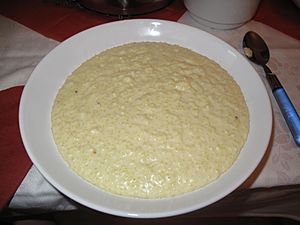
Millet is another grain used for porridge:
- Foxtail millet porridge is a main food in northern China.
- In Niger, porridge from pearl millet is a staple.
- Middle Eastern millet porridge is often spiced with cumin and honey.
- Milium in aqua was a millet porridge eaten in ancient Rome.
- Koozh is a millet porridge sold in Tamil Nadu, India.
Oat Porridge
Oat porridge is very common in English-speaking countries and Nordic countries. People have been eating oat porridge for thousands of years! Ancient remains of oat porridge have been found in 5,000-year-old Neolithic bog bodies.
Some types of oat porridge include:
- Groats, made from whole oats.
- Gruel, a very thin porridge.
- Owsianka, a traditional breakfast in Eastern Europe.
- In the UK, Ireland, and North America, porridge made from rolled oats or ground oatmeal is common. It's often just called "porridge" or "oatmeal".
- During the Napoleonic Wars, sailors in the Royal Navy ate burgoo, made from coarse oatmeal and water.
- Stirabout is an Irish porridge, traditionally made by stirring oats into boiling water.
Different Types of Oats
Oats for porridge come in different forms:
- Whole oats (groats)
- Cut oats (pinhead, steel-cut, or coarse oatmeal)
- Ground oats (medium or fine oatmeal)
- Rolled oats (steamed and flattened flakes)
The bigger the oat pieces, the more chewy the porridge will be. Steel-cut oats are thought to be digested slower than rolled oats. This can help keep your blood sugar steady and make you feel full longer.
Oats are a great source of dietary fiber. The oat bran part of the grain is especially healthy.
How to Make Oat Porridge
Oats are cooked in milk, water, or a mix of both. Some people like to soak the oats first, but tests show it doesn't make a huge difference. You can add many different flavors! Common additions include Demerara sugar, golden syrup, Greek yogurt, and honey. Some people also add cold milk or cream when serving.
Rice Porridge
Rice porridge is popular in many parts of Asia:
- Champorado is a sweet chocolate rice porridge from the Philippines.
- Congee is a very common East, Southeast, and South Asian dish of boiled-down rice.
- In China, congee (zhou or juk) can be served with century egg, salted duck egg, pork, or fried dough.
- In Indonesia and Malaysia, congee (bubur) comes in many types, like bubur sumsum (with coconut milk) or bubur ayam (with chicken).
- In Japan, congee (kayu) is often eaten with salt and green onions.
- In Korea, congee (juk) can have seafood, pine nuts, or mushrooms.
- In Thailand, congee (khao tom or jok) can have coriander, duck eggs, or chili.
- In Vietnam, congee (cháo) can be made with beef or chicken broth and ginger.
- In the Philippines, congee (lugaw or arroz caldo) often has saffron and ginger.
- Cream of Rice is an American rice porridge.
- Kheer (or Payasam) is a sweet Indian dish of rice boiled in milk.
Sorghum Porridge
Sorghum porridge is also eaten in some places:
- Mabela is a sorghum porridge eaten in South Africa and Zimbabwe.
- Tolegi is a sorghum porridge eaten in New Guinea.
- Tuwo or ogi is a Nigerian sorghum porridge.
Wheat Porridge
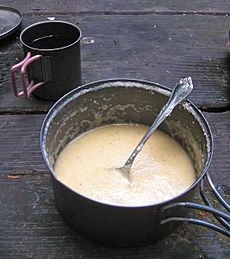
Porridge made from wheat is also common:
- Cream of Wheat is an American wheat porridge.
- Dalia is a simple cracked wheat porridge eaten in northern India and Pakistan.
- Frumenty was a boiled wheat porridge eaten in Roman times.
- Tejbegríz is a semolina dessert from Hungary.
- Malt-O-Meal is another brand of American wheat porridge.
- Semolina porridge is eaten in Czech Republic, Slovakia, and Croatia.
- Sour cream porridge is a Norwegian dish made with wheat flour and sour cream.
- Upma is a fried semolina porridge from southern India.
- Harees is an Arabian dish of boiled, cracked wheat and meat or chicken.
Other Porridge Types
- Flax porridge is often mixed with wheat and rye.
- Kasha is a general term for groats or porridge dishes, popular in Eastern Europe and Russia. It often refers to buckwheat porridge.
- In Ethiopia, Genfo is a thick porridge made from various grains and legumes.
- Pease porridge, made from dried peas, is a traditional English and Scottish porridge.
- Potato porridge is eaten in Norway.
- Quinoa porridge is made from the healthy quinoa grain.
- Rye porridge, like Ruispuuro in Finland.
- Spelt porridge.
- Tsampa is a toasted grain flour, usually barley, eaten in Tibet.
- Yam porridge/pottage is a main meal in Nigeria.
A Look Back: History of Porridge
Porridge has been a very important food for people around the world for thousands of years. It became common when societies started growing grains during the Neolithic period (the New Stone Age).
Porridge is often linked with Scotland. This is because oats grow well in the hilly Scottish lands. In 1775, a writer named Dr. Samuel Johnson joked that oats were "a grain which in England is generally given to horses, but in Scotland supports the people." Oats were brought to Scotland around 600 AD. Traces of barley porridge have been found in pots in the Outer Hebrides that are 2,500 years old!
In Northern Europe and Russia, porridge was a main food for a long time. It was often made from barley and could be savory, with meats, vegetables, and herbs added. Before people commonly had ovens and leavened bread, porridge was a simple way to cook grains.
|
See also
 In Spanish: Gacha para niños
In Spanish: Gacha para niños
- Asida, from the Arabian cuisine
- Barley gruel
- Congee, a rice porridge common across Asia
- Krentjebrij, a traditional Dutch porridge-like dessert
- List of porridges
- Macroom Oatmeal, the last traditionally stone-ground oatmeal in Ireland
- Quaker Oats, large multinational manufacturer, suppliers of Quaker Oats, Quaker Instant Oatmeal, etc.
- Ready Brek, a British brand of instant shredded oat cereal
- Scott's Porage Oats, a Scottish brand producing porridge sold nationally in the UK.
- Stoats Porridge Bars, a Scottish brand comprising porridge bars, organic porridge, oats, health food and oat bars.
- Tapioca pudding
- African cuisine
- List of African dishes


